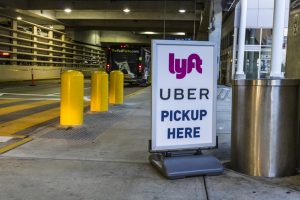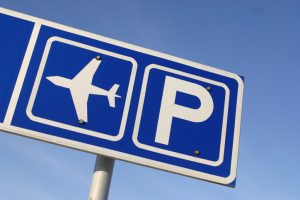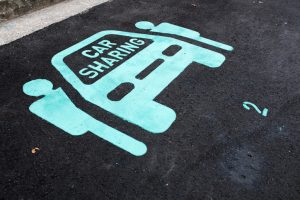By Brian Shaw, CAPP
AS MOBILITY PROFESSIONALS, we have to try to stay aware of trends in our industry. Most of us were caught off guard with the advent of transportation network companies (TNCs) such as Uber and Lyft and the impact they have had on curb space, traditional taxis, car-sharing, transit usage, parking demand, and traffic. What could be coming next that will affect our profession and industry? I will attempt to make some predictions, and I will be interested to see how right or wrong I am in the coming years.
Electrification of Transit Fleets
Batteries continue to get better. Consistent range, performance, and safety have made moving bus transit to an electric platform feasible, viable, and cost-effective. China has led the way in this trend, and North American transit properties, universities, and airports have begun to transition their bus fleets to electric. Bus manufacturers have emerged who specialize in electric buses while also collaborating with traditional bus companies on conversions.
EV Charging?
Many of us have installed electric-vehicle (EV) charging stations in our facilities. This may be due to a code requirement or as a way to attract EV owners to park in our facilities. But the range for EVs has dramatically improved; some EVs can go 100, 200, or more miles on a charge. Is EV charging still needed at worksites as battery range improves? Should EV charging be done at home, and should EV charging be free? Should fast or slow chargers be the option?
Transportation Network Companies
Is the growing use of Lyft and Uber a prelude to how life will be with autonomous vehicles (AVs)? Will we own cars in the future and need to park them? How should our facilities be designed and what features do they need if the vehicles can park themselves? For now, it may be prudent to develop staging areas for TNCs.
Pickup/Drop-off Curb Space
Given the increasing use of TNCs and the likely future advent of autonomous vehicles, our built environments will need to develop new design standards and operational use criteria to make the best use of limited curb space. Perhaps when parking demand declines, the curb space issue will be addressed by having fewer curbs in use for parking. At least for the foreseeable future, curb use and availability will remain a challenge.
Technology Instead of Travel
In more urban and suburban areas, this could lead to a growing need for short-term loading zones to accommodate delivery activities. Commuters may commute less or to various remote locations to facilitate remote working/working from home, reducing demand for monthly permits and parking and increasing need for daily permits. Meetings may take place online with improving video conferencing, reducing mid-day trips and parking demand. Why go to the theater if you can see the next Oscar winner from home? If your dinner can be easily delivered from your favorite restaurant, why go out? This trend should reduce retail parking demand, but it will increase demand for curb and loading areas, particularly in urban settings.
Microtransit
Will microtransit services reduce parking demand? Are they shifting trips from transit or using a personal bike? Are these inducing travel by making it easier and faster to travel short distances? Dockless electric scooters are making inroads in some cities and are becoming more regulated. Perhaps converting or adding dockless device parking where bike parking is located is prudent. It remains to be seen if these microtransit services will be profitable and worth incorporating into planning processes. When mobility-as-a-service becomes possible, microtransit should have a place in travel planning and seamless paying.
LPR and Gateless Parking
Can parking garages and lots be operated with license plate recognition (LPR)-based payment and enforcement exclusively?
Have we seen the end of parking meters, pay stations, and gate arms? Can parking be factored into emerging mobility-as-a-service solutions via LPR? When parking facilities become staging areas for TNCs and/or autonomous vehicles, automated vehicle detection and payments will be needed. While vehicles could be equipped with a device like an E-ZPass, all vehicles have a license plate that is valid everywhere. Perhaps LPR
becomes a way for AVs to pay for parking/staging/charging at a parking facility. If that is the case, will gates and pay stations be necessary? Until cash is gone and humans no longer drive and park, parking equipment should continue to be useful. However, the day is coming when barrier-free, LPR-based parking payment and enforcement will be the norm.
Amplification of Transportation
Is it possible to crack the challenge of real-time ride-sharing—trip, location, and time? Is this service best accomplished with TNCs and ride-matching apps versus dedicated vehicles and routes? When AVs can carry larger passenger loads, perhaps services such as Chariot and RidePal will be economically viable. Until then, daily ride-matching apps seem to have found a viable place. Combining daily ride-matching with LPR-based parking management should allow use of preferred carpool parking and sharing commuting costs for daily carpools. Transit agencies have begun considering using TNCs to provide on-demand transportation, particularly for lightly used routes or during off-peak service hours. Arguably, TNCs can be a more cost-effective way to provide needed transportation when ridership loads are low.
Adaptive Reuse
Under what conditions does it make sense to pay the extra upfront costs for adaptive reuse (see p. 36 of the May 2019 issue for more)? Depending on the location of the facility, age, design, and ownership, it may or may not make financial sense to build a parking facility to accommodate an autonomous vehicle future. Can the property be redeveloped? If so, perhaps when parking demand declines to the point where a garage is no longer needed, it may be best to redevelop the property.
A growing aspect of our roles as parking and mobility professionals is to stay aware and informed of these and other trends and advances in our profession. In some cases, our best approach is to wait and see how the trend plays out.
Read the article here.
BRIAN SHAW, CAPP, is executive director of parking and transportation at Stanford University, and co-chair of the IPMI Sustainability Committee. He can be reached at bshaw2@stanford.edu
 New Jersey Governor Phil Murphy last week signed a law requiring ride-share (TNCs) vehicles to display more identifying information. The law came after the murder of a woman who got into a vehicle she believed to be an Uber.
New Jersey Governor Phil Murphy last week signed a law requiring ride-share (TNCs) vehicles to display more identifying information. The law came after the murder of a woman who got into a vehicle she believed to be an Uber.
 By Tim Maloney
By Tim Maloney An academic study released last week showed that transportation network companies (TNCs) such as Uber and Lyft are taking a bite out of parking demand, at least in Denver, Colo.
An academic study released last week showed that transportation network companies (TNCs) such as Uber and Lyft are taking a bite out of parking demand, at least in Denver, Colo. By Jeff Petry
By Jeff Petry On-street parking is being traded for curbside drop-off/pick-up zones in five places in Washington, D.C., as part of an expanding program.
On-street parking is being traded for curbside drop-off/pick-up zones in five places in Washington, D.C., as part of an expanding program. By L. Dennis Burns, CAPP
By L. Dennis Burns, CAPP